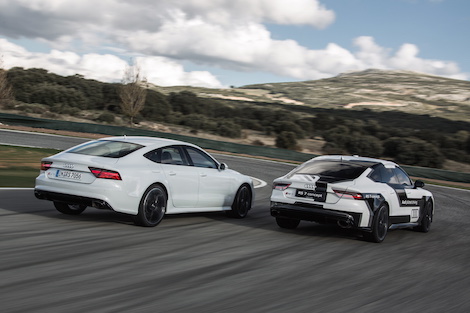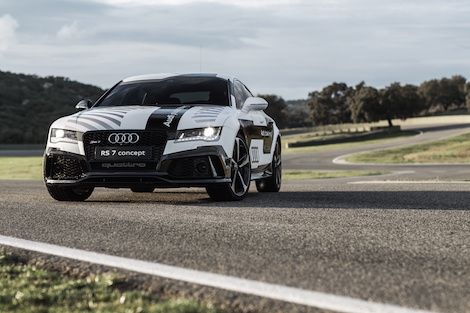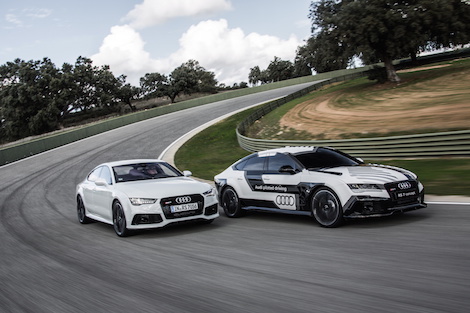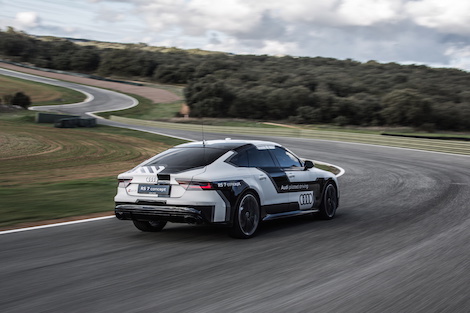Let's not mince words here; the Audi RS 7 is a behemoth as far as performance cars go. The regulations of today may call for a reduction in emissions, but this appears to have spurred the Ingolstadt engineers on. Its engine may have shrunk to 'just' 4.0 litres in capacity, but the pair of twin-scroll turbochargers that has been appended to the V8 exhaust system means that it still churns out an impressive 560hp. Equally impressive is the torque - all 700Nm of it.
Audi of course is keen to express just how easy the RS 7 is to drive, despite all that performance, and to be fair, it has a valid argument. Should you simply desire a sedate amble into town, the 560hp Audi will do just that with absolutely no pomp or ceremony. In fact you could find yourself questioning whether you were in an RS model at all such is the level of civility.
There are, of course, a number of not-so-subtle reminders dotted throughout the cabin, namely the RS-embossed quilted leather sports seats that cosset you, the flat-bottomed steering wheel and the flashes of carbon-fibre accents.
However, the real reason most RS 7 buyers decide to hand over the €146,350 starting price is for the performance, which is precisely why I find myself at the Ascari race track in southern Spain. This should be the ideal place to experience what an Audi RS 7 is capable of doing.
It is a cold but sunny winter morning and I sip my coffee as I sign a number of the usual disclaimer documents that tend to accompany such track excursions. It is all very relaxed, but far from blasé. Every now and again, the calm is broken by the sound of one of Ingolstadt's finest as it blasts along the main straight. Upshifts sound like distant muffled rifle shots ringing out, echoing around the circuit.
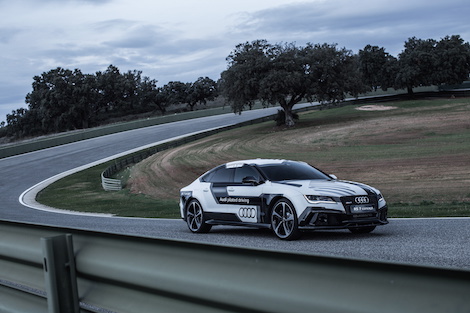
As the RS 7 slopes into the pit lane ready for me, I don my open-face helmet and ease into the wonderfully supportive leather clad sports seats, adjusting mine ever so slightly to get it just right. I press the machined Start button, which summons the Audi's V8 to life. I select Drive, amble down the pit lane and out onto the circuit.
Approaching my first flying lap the RS 7 feels planted and, as I push through the first few corners, there's little in the way of body roll. The first of Ascari's three straights tests the car's digital speedometer as it struggles to keep up with the onslaught of acceleration.
I hit the brake pedal at the final marker before the 90-degree left, putting the carbon ceramic brakes - a €13,250 option - to the test, scrubbing off the guts of 140km/h in what must be no more than 50 metres - and it does so in an almost nonchalant manner. The RS 7 remains flat and composed through the corner in a fashion that almost belittles the task.
However, such is the abrasive nature of the surface of Ascari the quattro four-wheel-drive system does feel to be working hard to lay down the power when exiting corners. I can almost feel the sticky rubber being eroded and chewed up by the asphalt.
Such is the addictive nature of the instantaneous power delivery it is easy to be sucked into the car's speed and performance but you do need to keep its 2,540kg weight in mind as the Audi is still bound by the laws of physics and tyre technology, especially when it comes to the slower corners.
As my playtime ends, I cruise back into the pit lane and park up my five-seat missile. It is a hugely impressive car that certainly flatters the driver. The result? I mustered a personal best of 2:12.119 seconds.
But Audi has one more ace up its technological sleeve and it's parked on the start line waiting for me. Bobby is an RS 7 like no other, which I am about to discover as I sit into the passenger seat.
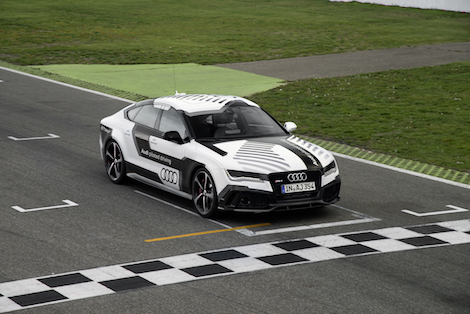
I say passenger seat because this time around I'm not driving, Bobby is - this is Audi's self-driving RS 7, or as it prefers to call it, Piloted Drive prototype.
I'm not totally alone though; beside me in the driver's seat is one of the lead engineers behind the project, who must accompany me for a number of legal and technical reasons.
In the interests of science and sport, we will also be recording the lap time to compare it against my own. The engineer talks me through a number of points about the car before we begin. I can tell he is trying hard to curb his enthusiasm.
Once he receives the all-clear, he hands control over to Bobby and I begin to watch very closely in the same way one would watch a magician trying to see how the trick is done. Bobby fires up the engine, engages Drive and launches away from the start line.
It becomes immediately clear that this is no gentle parade lap. As we race towards the uphill chicane of turn one, I can't help but feel slightly unnerved as I anticipate the braking point. Just the slightest dab of the brakes is applied and I watch the steering wheel flick right then left with no input from either of us. It's spooky.
At this point, the engineer strikes up conversation and starts to explain some of the technical features of Bobby, whilst 'he' instantly corrects some snap oversteer as we rattle over the kerbs. The performance of the RS 7 seems that bit more impressive experienced from the passenger seat and watching the steering wheel act by itself without any human input is simply mesmerising.
One of the key differences between Bobby and a human driver is when it comes to braking. Unlike me, Bobby doesn't have a sense of mortality. That's not to say that the car is reckless, far from it. No, the key difference between Bobby and me is the vast array of sensors and computational power that Bobby has, which it uses to its advantage.
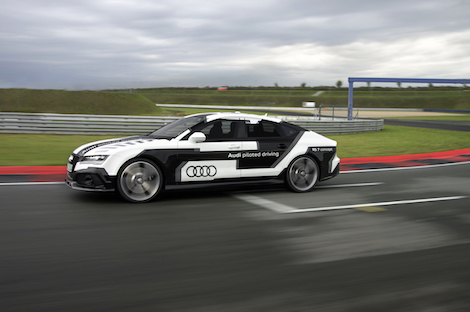
It knows precisely how heavy it is, its tyre pressures, exact speed and position on track, all of which it can use to calculate the optimum braking point every time. Neither does it have a little thing called fear. That also helps.
After our second flying lap is complete, we humans regain control of the car by simply taking hold of the steering wheel. Driving back into the pit lane, I am somewhat at a loss for words as to what just happened.
It is, by far, one of the most technically impressive feats I have ever experienced in all my time as a motoring journalist. Its lap time? 2:14.795 - barely 2.5 seconds off my time, and that was with one extra person on board too.
Over a much needed coffee, Thomas Müller, Audi's Head of Development for Braking, Steering and Driver Assistance, explains how Bobby was developed in a remarkably short time frame.
It began in February of 2014 during a conversation with Prof. Dr. Ulrich Hackenberg, Audi's Chief Technical Officer, whereby they discussed having something new to show off at the finals of the German DTM Touring Car Championships at the Hockenheim Ring.
Audi had already developed some forms of autonomous driving but only in limited and controlled environments. Nobody had done high-speed autonomous driving to this level. And so, Bobby was conceived.
Testing began in earnest with the team of engineers working on two identical development cars (I'll come back to that in a bit) mainly at the Oschersleben circuit.
The cars are designed to drive only on a racetrack environment and don't have the capability to interact with other cars, hence why they only drive on the track when it is empty. Audi's engineers did build in a safe redundancy system that brings the car to an immediate halt should it detect an object or person in its path. It can also be shut down remotely.
As for the technology that powers it, well, both cars started as standard production RS 7s. Both Bobby and AJ, its twin, make use of some existing technology such as the adaptive cruise control radar. In addition to this are high definition cameras mounted at the top of the windscreen to observe and record the car's surroundings.
Apparently one camera is sufficient, but Audi engineers like to make sure that they have all the bases covered. The witchcraft I witnessed with the steering is controlled through the car's standard electromechanical power steering while servo motors control the throttle and braking actions.
The brains of the car lie in the boot, which is crammed with banks of computers and data loggers that calculate and record the car's every move. A bespoke electronic control unit was created for Bobby to manage its autonomous driving and this one circuit board has more computing power than the entire electrical system in a standard Audi A4. All of which I thought was impressive enough until I learned how it works.
Full disclosure here: I was under the impression that Bobby would be shown how to complete a hot lap by a driver and then recreate this performance for its passengers. But no, this isn't the case.
Müller tells me the engineers simply drive the car around the far left of the circuit for one lap and repeat the process on the far right-hand side. Bobby uses its on-board camera system to record these track boundaries, as it were.
Its powerful computers then crunch the data and it is the car, not the engineers, that plans its lap. Bobby determines how fast it can go, where to brake, where to turn into a corner, when to get back on the power, all by itself. BY ITSELF.
Add to that its ability to correct for under- or oversteer as well as compensate for tyre wear and weight changes throughout a day on track and it soon becomes far, far more impressive than first thought. Taking these wear-related issues out of the equation, Müller says that the cars could lap consistently to within a tenth of a second all day long.
Currently, development of Bobby continues as a research device as well as a seriously cool marketing tool. As for now, Bobby cannot drive on the public road, but over in America its sibling can.
Jack is an Audi A7 Piloted Drive and recently he undertook a journey from Silicon Valley to Las Vegas for the 2015 Consumer Electronics Show. This drive was some 900 kilometres long. At present, America remains one of the only countries in the world that permits autonomous cars to drive on public roads at the same time as other road users (in certain states).
It is clear that the technology is definitely getting there and advances in autonomous vehicles are being made at a rapid pace. Now, perhaps, legislation may be the only thing that stands in the way of us having cars capable of taking full control when required. As for AJ, Bobby's twin, well, AJ is every bit as talented as Bobby is; in fact, they lap to within a tenth of a second of each other on every lap.
However, what is more fascinating is that, despite having identical hardware and software, each car has developed noticeably different driving styles, a feat that not even the engineers can explain. Therefore, with that in mind, perhaps we shouldn't be rushing so fast into this autonomous driving technology until we fully understand it, and them.





















